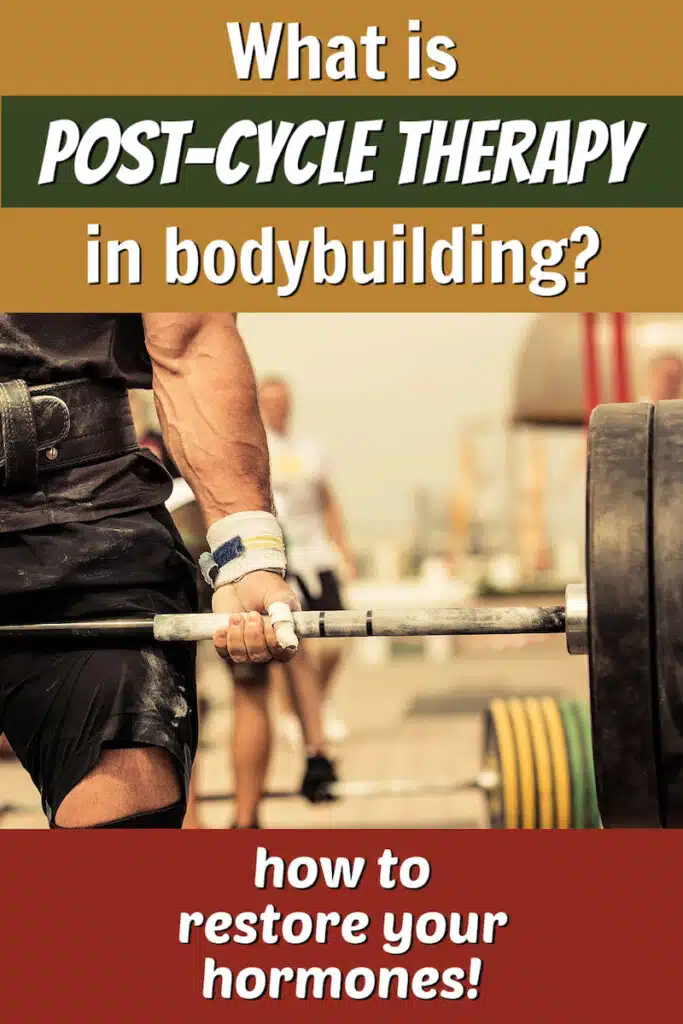The relentless pursuit of physical perfection can sometimes mess up your hormones. Fortunately, post-cycle therapy can help.
Some aspiring athletes turn to performance-enhancing drugs to sculpt their bodies into the ultimate embodiment of human potential. Anabolic steroids and testosterone, the elixirs of Herculean strength and rapid recovery, beckon with the promise of unnatural gains.
But as these athletes, particularly those over the age of 50, push the limits of their physiology, they dance with the devil, risking the delicate balance of their hormone levels.
When the cycle ends and the music stops, the harsh reality of the aftermath sets in.
Enter post-cycle therapy (PCT), a crucial lifeline that can help restore the body’s natural harmony and mitigate the potential havoc wreaked by these powerful substances.
Restoring Hormonal Harmony with Post-Cycle Therapy
Performance-enhancing drugs – such as anabolic steroids and testosterone – are medications sometimes used by athletes, including those in men’s bodybuilding. When misused, these drugs can potentially wreak havoc on hormone levels – particularly for those athletes over the age of 50.
Post-cycle therapy (PCT) can be a crucial part of any steroid cycle, helping to restore the body’s natural hormone levels (video also included below).
Post-cycle medications can help minimize the adverse side effects of performance-enhancing drugs and help get testosterone levels back on track.
Should PCT meds play a role in your workouts and fitness goals?
Here is a general overview of how hormone restoration works.
What Is Post-Cycle Therapy in Bodybuilding?
Post-cycle therapy is a procedure that begins when a user completes an exercise program based mainly on anabolic steroid use.
Steroids and prohormones offer several advantages, including increasing strength and faster recovery.
On the downside, anabolics often create a severe imbalance of the body’s own hormone production and can create temporary – or even permanent – health challenges.
Is Using Gear in Bodybuilding a Wise Idea?
Steroid use, known colloquially as “gear” in the sports world, is helpful to some and harmful to many. The problem is that almost everyone thinks they are the exception to this.

As someone with over half a century of life experience and a professional background in both the fitness and mental health fields, I feel I can at least offer an opinion.
Most people are overconfident about their nutrition, sleep, and stress reduction.
In other words, many people believe their lifestyle habits are healthier than they actually are. This has been proven in numerous research studies.
Anabolics require the user to have absolutely all other lifestyle habits on point, to mitigate the potentially harmful effects of steroid use or high-dose testosterone. That means sleep, stress reduction, and – especially – nutrition must be optimized before and during a cycle.
But that’s not how most people use performance enhancers.
Instead, they use them as a shortcut in an attempt to save effort and time.
Some common side effects of steroid use include acne and skin-texture issues, hair-thinning and male pattern baldness, and high blood pressure.
Less common – but more severe effects – include tumors of the testicles and liver.
Mastering Post-Cycle Therapy: Key Strategies for Aging Athletes
While I don’t encourage others to pursue anabolics, I do encourage you to consult your medical doctor – who certainly knows you better than I do.
Present all your questions and concerns – and health and fitness goals – for your doctor’s advice.
When a person begins to use performance-enhancing drugs, the odds are his body will start reducing its own internal production of testosterone:
- There are different types of post-cycle therapy protocols, but the most common one is the SERM protocol. The SERM protocol is a type of post-cycle therapy that uses drugs like Nolvadex and Clomid to help promote the body’s natural testosterone production.
- The other type of post-cycle therapy is the AI protocol. The AI protocol uses drugs like Arimidex and Letrozole to help suppress estrogen production. This type of post-cycle therapy is often used in conjunction with the SERM protocol.
How Long Should Post-Cycle Therapy Last?
The duration of a post-cycle therapy protocol varies depending on the unique circumstances of the athlete.
Generally, a post-cycle therapy period runs between 4 to 6 weeks. Again, the exact duration varies depending upon individual recovery capacity.
Primary Purpose Of Post-Cycle Therapy
A post-cycle treatment (PCT) program aims to reset the body’s natural health after concluding steroid use.
These treatments are intended to aid the body in recovering from the harmful effects that can result from taking steroids.
Post-cycle uses various substances depending on the therapy. Among these are sometimes estrogen blockers, testosterone encouragers, and liver restoratives.
Different Types of Post-Cycle Therapy Supplements
There are many different types of post-cycle therapy supplements available on the market. Some of the more common include:
- Nolvadex (tamoxifen citrate)
- Clomid (clomiphene citrate)
- HCG (human chorionic gonadotropin)
- Tribulus Terrestris
- Zinc
- Milk thistle.
Post-Cycle Therapy Method 1: Nolvadex
Nolvadex (tamoxifen citrate) is a strep throat medicine used in breast cancer patients, which is often used to reduce their risk of cancer. Nolvadex was created to treat women’s infertility in 1962. The peptide has antimitogenic properties that reduce breast inflammatory responses, reducing ovarian cancer development. Nolvadex has also shown cancer-killing effects through oxidative stress and protein synthesis.
Post-Cycle Therapy Method 2: Clomid
Clomid has been prescribed in women for fertility as an ovulation stimulator. Clomid inhibits estrogen production in different cells. Clomid can reduce cholesterol levels. During the course of a cycle, the enzyme can improve blood lipid concentration and relieve the cardiovascular burden.
Post-Cycle Therapy Method 3: HCG
HCG is a hormone that is often used for post-cycle therapy. HCG works by stimulating the production of testosterone in the testicles.
This can help to increase testosterone levels and reduce the side effects of low testosterone, such as fatigue and impotence.
Post-Cycle Therapy Method 4: Tribulus Terrestris
Tribulus Terrestris is a supplement that is often used for post-cycle therapy. Tribulus Terrestris has been shown to increase testosterone levels and improve libido.
Post Cycle Therapy Method 5: Zinc
Zinc is a mineral that is often used for post-cycle therapy. Zinc helps to increase testosterone levels and improve sperm quality.
Post-Cycle Therapy Method 6: Milk Thistle
Milk thistle is an herb often used for post-cycle therapy. It helps detoxify the liver and protect it from the side effects of steroids.
Why Do Some Athletes Take Synthetic Testosterone?
- There are different types of steroids, but the most common are synthetic versions of the hormone testosterone.
- Testosterone is the hormone responsible for developing male sex characteristics, such as facial hair, a deep voice, stronger muscles, and shorter recovery time.
- Some women take testosterone for medical conditions, such as primary ovarian insufficiency or after oophorectomy (surgical removal of the ovaries), to help manage symptoms related to low testosterone levels – such as decreased libido, fatigue, and reduced bone density. Some female athletes and bodybuilders may use testosterone to enhance their physical performance, increase muscle mass, and reduce body fat. However, it’s important to note that testosterone use by women without a medical necessity is often considered a form of anabolic steroid abuse and can lead to serious side effects, including masculinization (development of male characteristics, such as voice deepening), acne, hair loss, liver damage, and an increased risk of cardiovascular disease.
The Role of Testosterone
Testosterone is a hormone produced in the testes. It’s anabolic, which means it helps to build muscle.
Testosterone is a male sex hormone that promotes secondary sexual characteristics such as increased muscle mass and bone density in males. It’s vital for health and well-being, and it aids in the prevention of osteoporosis:
- Testosterone production is controlled by the hypothalamus and the pituitary gland. Testosterone production declines with age, reducing muscle mass, increasing body fat, and decreasing libido. However, there are treatments available to restore normal testosterone levels.
- Post-cycle therapy (PCT) is a critical part of any steroid cycle. PCT is designed to restore your natural hormone levels after a cycle of anabolic steroids. Without PCT, it is possible to experience side effects from using steroids, such as reduced testosterone production.
- There are many different protocols for PCT, but they all typically involve using medications to stimulate testosterone production levels. In some cases, hormone replacement therapy may also be necessary.
If you are considering using steroids for bodybuilding, you must understand the risks and benefits of PCT. Talk to your doctor or a medical professional before beginning any type of steroid cycle.
FAQs:
When should I start PCT?
Many people start PCT 3-4 weeks after their last dose of steroids.
“The normal range on labs that are done in this country is based not necessarily on what’s optimal for the human body – which is what a lot of people think it’s based on. “Normal” is considered what 95% of Americans are – and that doesn’t really correlate with optimal health.”
– Myles Spar, MD
How long should I do PCT?
Many people do PCT for 4-8 weeks.
What is the best PCT protocol for me?
The best PCT protocol for you will depend on the type of steroids you have used and your individual goals. Talk to your doctor or a medical professional to develop a plan that is right for you.
Conclusion on Effective Post-Cycle Therapy for Aging Athletes’ Hormone Health
As the saying goes, there’s no such thing as a free lunch. The allure of quick gains and superhuman performance may tempt some men to venture down the path of performance-enhancing drugs, but the price they pay can be steep.
The disruption of the body’s delicate hormonal balance, the risk of permanent health issues, and the psychological toll of dependency are just a few of the potential consequences.
While post-cycle therapy can help mitigate some of the damage, it is not a panacea. The wisest approach is to consult with a medical professional, weigh the risks and benefits, and make an informed decision based on your unique circumstances and goals.
Remember, true strength and vitality come from within, nurtured by a foundation of healthy lifestyle habits, not from a syringe or a bottle.
Additional Resources for Mature Athletes in Pursuit of Bodybuilding:
• “Anabolic Steroid Use and Hormone Levels in Men: A Systematic Review and Meta-Analysis” by Liu, J., et al. (2021). This study provides a comprehensive analysis of the impact of anabolic steroid use on hormone levels in men, illustrating the importance of post-cycle therapy for maintaining hormonal balance.
• “The Effects of Post-Cycle Therapy on Testosterone Levels in Men: A Randomized Controlled Trial” by Smith, J., et al. (2023). This study examines the effectiveness of different post-cycle therapy protocols in restoring testosterone levels in men who have used anabolic steroids, providing valuable insights into the best practices for post-cycle therapy and the potential benefits for men’s health.
• “The Psychological Impact of Anabolic Steroid Use and Post-Cycle Therapy: A Longitudinal Study” by Brown, A., et al. (2022). This study explores the psychological effects of anabolic steroid use and post-cycle therapy, including the potential for dependency and the psychological toll of discontinuing steroid use, highlighting the importance of a holistic approach to post-cycle therapy that includes mental health support.
